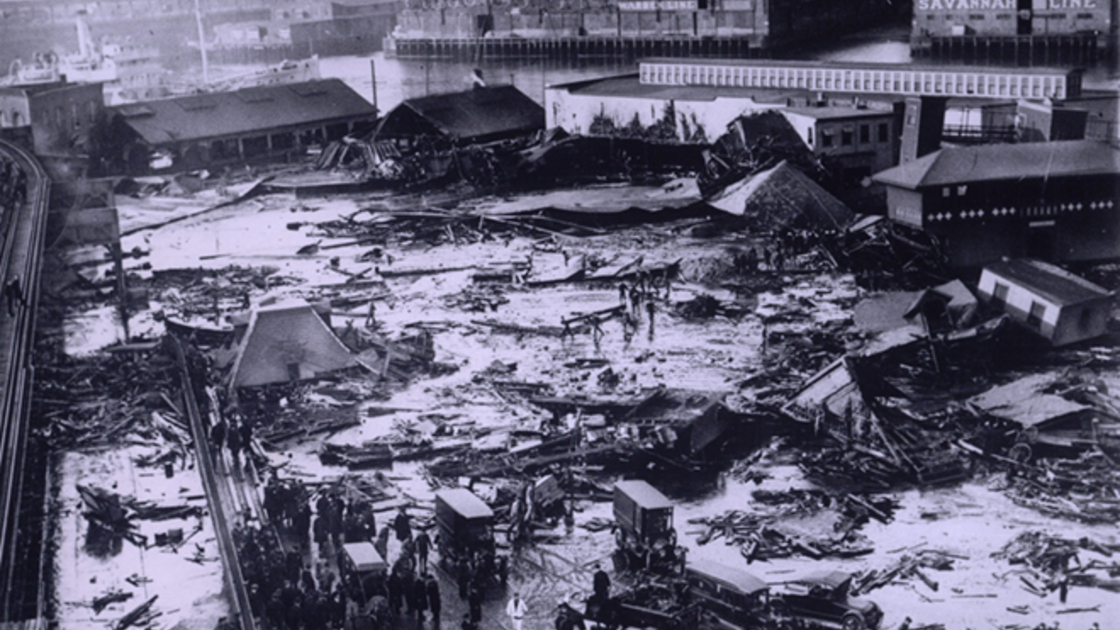Imagine a 25-foot wave rushing toward you at 35 miles per hour, knocking trains off their tracks, and crushing buildings.
Now imagine that it’s made of molasses. Thick, sticky, sickeningly sweet molasses.
While that might sound like a slightly disgusting metaphor, the Boston Molasses Disaster actually happened. Sometime around noon on Jan. 15, 1919, a huge molasses tank burst and flooded several blocks in north Boston with gooey sweetener. One little boy, Anthony di Stasio, bodysurfed the crest of the wave and, incredibly, survived. Some others weren’t quite so lucky: 21 people were killed, either by debris or the molasses itself, and around 150 were injured. The mess took over two weeks to clean up, and even then the harbor stayed brown for months. (I suppose it would have gone well with the tea.)
Amazingly, that wasn’t the first time something like that happened: the British did it a century earlier with the London Beer Flood. On Oct. 16, 1814, multiple beer vats burst and sent about 320,000 gallons of beer gushing down the road. This particular sticky wave wrecked five buildings, including, in a moment of beautiful irony, a pub.
There is an important lesson we can learn from this: You can’t ignore problems and hope they’ll go away. Both incidents occurred because the storage tanks were dilapidated and unstable. In the Boston Molasses Disaster (which I shall refer to from now on as the Boston Incident, owning to my inability to write “Molasses Disaster” with a straight face), the tank had already been leaking for months. So much molasses had been seeping through the cracks that locals were collecting the drips for personal use. But instead of actually fixing the leaks or strengthening the tank, the owners painted it brown to hide the evidence. This really came back to bite them when warm weather suddenly hit and caused the molasses to expand. The poor neglected tank just couldn’t take it. Had they fixed the problem instead of sweeping it under the proverbial carpet, they would have saved 21 lives.
Unfortunately, the peoples of Israel today haven’t learned from the Boston Incident. Problems like an unpayable national debt and a nuclear-capable Iran are barely even thought of, let alone dealt with. Our nations are like one-year-olds thinking that if they cover their eyes, Daddy can’t see them anymore.
It’s easy for us, knowing the truth, to criticize politicians and the media—but what about our own lives? I know that for me, personally, it’s very tempting to brush issues and tasks off like they aren’t there. All too often, we paint over the leaks instead of repairing them, and eventually the tank bursts.
So how can we prevent a disaster in our own lives? Firstly, before anything else, we need to get God involved. Our Father is the one who gives us the strength to take action against the problems in our lives, and the will to tackle issues even when we don’t want to. “For it is God which worketh in you both to will and to do of his good pleasure” (Philippians 2:13). But He doesn’t just help us with the problems we know about: if we ask, as David did, He will show us our secret faults and help us find the less visible cracks (Psalm 19:12).
Secondly, we need to determine where our personal holes are. Perhaps you keep procrastinating what seems like an enormous task, like a paper for school. Maybe there’s a chore you hate, like taking out the trash, and you keep conveniently forgetting to do it until, not so conveniently, the can starts to overflow.
One great way to spot and deal with problems like this is to keep a detailed planner or calendar. Try writing down all your responsibilities for each day—errands, chores, homework, promises to others. If you have everything you need to do on paper in a place you see frequently, tasks become a lot harder to ignore. This may sound over the top, but it genuinely works—even for problems that run deeper than simple procrastination. Some holes aren’t outside difficulties we face, but our own inward faults. These still require planning, and a pen and paper are still an invaluable aid. If we write down our spiritual issues and our plan of attack for overcoming them, it helps solidify in our minds exactly what we’re fighting and reminds us what we need to focus on.
Finally, once we have enlisted our Father’s aid and written up our plan, we need to plug the hole. Don’t wait until the issue explodes; throw yourself at the task as soon as possible, trusting that God will come to your aid. It takes courage to confront problems or things we don’t want to do; after all, we wouldn’t be avoiding the issues in the first place if they were easy to conquer. But facing up to unpleasant tasks or our own faults is well worth the effort. Each small success, each leak repaired, adds to our character and brings us closer to our goal of perfection (Matthew 5:48).
Let’s stop hiding from our flaws and strive to repair our lives completely—instead of finding ourselves in a sticky situation.
